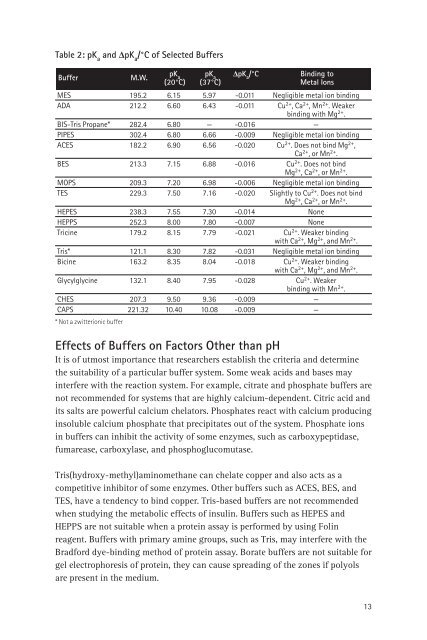A guide for the preparation and use of buffers in biological systems
A guide for the preparation and use of buffers in biological systems
A guide for the preparation and use of buffers in biological systems
You also want an ePaper? Increase the reach of your titles
YUMPU automatically turns print PDFs into web optimized ePapers that Google loves.
Table 2: pK a<br />
<strong>and</strong> DpK a<br />
/°C <strong>of</strong> Selected Buffers<br />
Buffer<br />
M.W.<br />
pK a<br />
pK a<br />
DpK a<br />
/°C B<strong>in</strong>d<strong>in</strong>g to<br />
(20°C) (37°C) Metal Ions<br />
MES 195.2 6.15 5.97 -0.011 Negligible metal ion b<strong>in</strong>d<strong>in</strong>g<br />
ADA 212.2 6.60 6.43 -0.011 Cu 2+ , Ca 2+ , Mn 2+ . Weaker<br />
b<strong>in</strong>d<strong>in</strong>g with Mg 2+ .<br />
BIS-Tris Propane* 282.4 6.80 — -0.016 —<br />
PIPES 302.4 6.80 6.66 -0.009 Negligible metal ion b<strong>in</strong>d<strong>in</strong>g<br />
ACES 182.2 6.90 6.56 -0.020 Cu 2+ . Does not b<strong>in</strong>d Mg 2+ ,<br />
Ca 2+ , or Mn 2+ .<br />
BES 213.3 7.15 6.88 -0.016 Cu 2+ . Does not b<strong>in</strong>d<br />
Mg 2+ , Ca 2+ , or Mn 2+ .<br />
MOPS 209.3 7.20 6.98 -0.006 Negligible metal ion b<strong>in</strong>d<strong>in</strong>g<br />
TES 229.3 7.50 7.16 -0.020 Slightly to Cu 2+ . Does not b<strong>in</strong>d<br />
Mg 2+ , Ca 2+ , or Mn 2+ .<br />
HEPES 238.3 7.55 7.30 -0.014 None<br />
HEPPS 252.3 8.00 7.80 -0.007 None<br />
Tric<strong>in</strong>e 179.2 8.15 7.79 -0.021 Cu 2+ . Weaker b<strong>in</strong>d<strong>in</strong>g<br />
with Ca 2+ , Mg 2+ , <strong>and</strong> Mn 2+ .<br />
Tris* 121.1 8.30 7.82 -0.031 Negligible metal ion b<strong>in</strong>d<strong>in</strong>g<br />
Bic<strong>in</strong>e 163.2 8.35 8.04 -0.018 Cu 2+ . Weaker b<strong>in</strong>d<strong>in</strong>g<br />
with Ca 2+ , Mg 2+ , <strong>and</strong> Mn 2+ .<br />
Glycylglyc<strong>in</strong>e 132.1 8.40 7.95 -0.028 Cu 2+ . Weaker<br />
b<strong>in</strong>d<strong>in</strong>g with Mn 2+ .<br />
CHES 207.3 9.50 9.36 -0.009 —<br />
CAPS 221.32 10.40 10.08 -0.009 —<br />
* Not a zwitterionic buffer<br />
Effects <strong>of</strong> Buffers on Factors O<strong>the</strong>r than pH<br />
It is <strong>of</strong> utmost importance that researchers establish <strong>the</strong> criteria <strong>and</strong> determ<strong>in</strong>e<br />
<strong>the</strong> suitability <strong>of</strong> a particular buffer system. Some weak acids <strong>and</strong> bases may<br />
<strong>in</strong>terfere with <strong>the</strong> reaction system. For example, citrate <strong>and</strong> phosphate <strong>buffers</strong> are<br />
not recommended <strong>for</strong> <strong>systems</strong> that are highly calcium-dependent. Citric acid <strong>and</strong><br />
its salts are powerful calcium chelators. Phosphates react with calcium produc<strong>in</strong>g<br />
<strong>in</strong>soluble calcium phosphate that precipitates out <strong>of</strong> <strong>the</strong> system. Phosphate ions<br />
<strong>in</strong> <strong>buffers</strong> can <strong>in</strong>hibit <strong>the</strong> activity <strong>of</strong> some enzymes, such as carboxypeptidase,<br />
fumarease, carboxylase, <strong>and</strong> phosphoglucomutase.<br />
Tris(hydroxy-methyl)am<strong>in</strong>omethane can chelate copper <strong>and</strong> also acts as a<br />
competitive <strong>in</strong>hibitor <strong>of</strong> some enzymes. O<strong>the</strong>r <strong>buffers</strong> such as ACES, BES, <strong>and</strong><br />
TES, have a tendency to b<strong>in</strong>d copper. Tris-based <strong>buffers</strong> are not recommended<br />
when study<strong>in</strong>g <strong>the</strong> metabolic effects <strong>of</strong> <strong>in</strong>sul<strong>in</strong>. Buffers such as HEPES <strong>and</strong><br />
HEPPS are not suitable when a prote<strong>in</strong> assay is per<strong>for</strong>med by us<strong>in</strong>g Fol<strong>in</strong><br />
reagent. Buffers with primary am<strong>in</strong>e groups, such as Tris, may <strong>in</strong>terfere with <strong>the</strong><br />
Brad<strong>for</strong>d dye-b<strong>in</strong>d<strong>in</strong>g method <strong>of</strong> prote<strong>in</strong> assay. Borate <strong>buffers</strong> are not suitable <strong>for</strong><br />
gel electrophoresis <strong>of</strong> prote<strong>in</strong>, <strong>the</strong>y can ca<strong>use</strong> spread<strong>in</strong>g <strong>of</strong> <strong>the</strong> zones if polyols<br />
are present <strong>in</strong> <strong>the</strong> medium.<br />
13
















